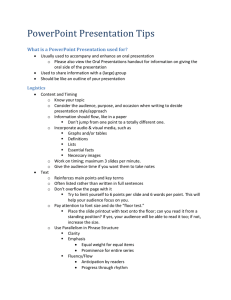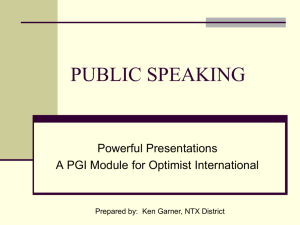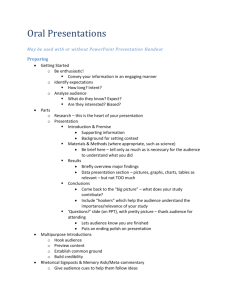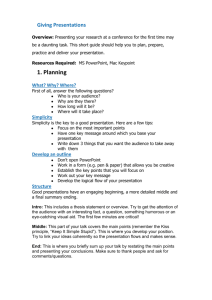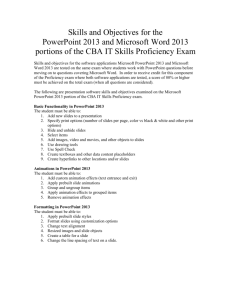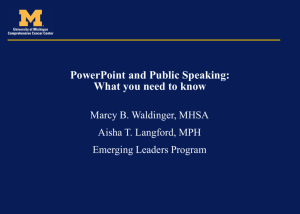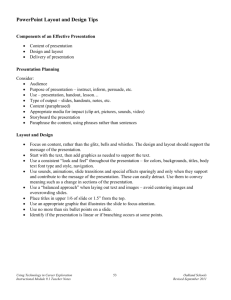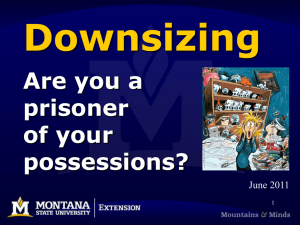ppt
advertisement
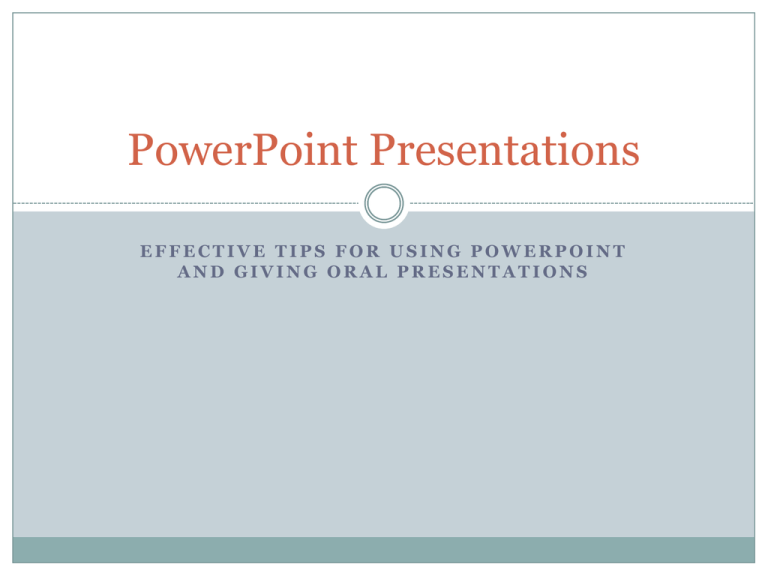
PowerPoint Presentations EFFECTIVE TIPS FOR USING POWERPOINT AND GIVING ORAL PRESENTATIONS What is a PowerPoint Presentation used for? Used to accompany & enhance oral presentation Used to share information with (large) group Used like an outline of your presentation Content and Timing Know your topic Consider audience, purpose, occasion when deciding style and approach Information should flow Don’t jump from 1 point to a totally different one Incorporate Graphs and/or tables, definitions, lists, essential facts, necessary images Work on timing Maximum 3 slides per minute Give the audience time for notes Text List rather than full sentences (often) Pay attention to font size & do “floor test” Place slide printout on floor: can you read it standing? If not, increase the font size Reinforces main points & key terms Don’t overflow page Try to limit to 6 points per slide & 6 words per point Benefits of Using Parallelism in Phrase Structure Clarity Emphasis Equal weight for equal items Prominence for entire Series Fluency/Flow Anticipation by readers Progress through rhythm Assertion-Evidence Structure Helps: Shape an argument-based presentation Audience understand the content Audience engage with speaker and vice versa Often features sentence- assertion headline supported by visual evidence Example to left Visual Images illustrate/highlight main points Select carefully Appropriate Make sure can be seen Select colors with care Use colors that work well on screen Use colors that can be seen Keep slides unified Try a master slide Minimize special effects Avoid switching between programs DO: Choose a single background for presentation Use simple, clean fonts in a size that can be seen clearly Use white space to set off text & visual Make sure slides are placed logically & use a heading for each slide Write in bulleted format & use consistent phrase structure Provide essential information only Key words Definitions when necessary Use direct, concise language Text to minimum Do NOT: Clutter the slide with graphics Use complicated fonts Add superfluous information Put down every word you are going to say Use images if they will distract Use hard to read color combinations DO try to use high contrast combinations FOCUS – PLAN – PRACTICE FOCUS on main points you want to make PLAN layout of presentation Does everything fit? PRACTICE the entire presentation before you present. If possible, use screen/projector Have someone watch & review Tips FROM: MICROSOFT ABOUT.COM DESKTOP PUBLISHING THE WRITING CENTER AT GEORGE MASON UNIVERSITY Microsoft Tips Grab viewer’s attention Use space effectively Use theme, visual, audio, graphics and animations Clearly communicate information Enhance if not overused Stay in control Keep file size manageable Use the tools to get it right the first time Turn off/manage AutoCorrect options Know exactly what viewers will see Outline presentation Masters and layouts save time & look better Consider differences between on-screen and print-outs Use note pages and handouts http://www.microsoft.co m/atwork/skills/present ations.aspx About.com Desktop Publishing Tips Match Design to Purpose Entertain, inform, persuade, sell, etc Light-hearted or formal? Keep it simple & cut the clutter Be consistent Use templates to help http://desktoppub.about.c om/od/microsoft/bb/pow erpointrules.htm The Writing Center at George Mason University Visuals Images MUST be relevant & enhance Tables, charts, graphs Easy to read & understand Text Keep to minimum Use white space to set off blocks of text Use bullet points as default format PROOFREAD Oral Presentations PREPARING PRESENTING Preparing Getting started Identify expectations (How long? Intent?) Analyze audience (What do they know? Expect? Are they interested? Biased?) Parts Research Presentation: Introduction & Thesis, Supporting, Conclusion Multipurpose Introductions Hook audience Preview content Establish common ground Build credibility Rhetorical Signposts & Memory Aids/Metacommentary Give audience cues to help follow ideas Numbers Old-to-New transitions Parallel sentence structure Repeat key words/ideas Restate thesis as transition to new idea Group set of ideas together under single heading Give short internal summary Explain why telling specific information Strategies to Highlight Important Points Repeating/reiterating Key words/vocab Flagging “If you remember just one thing…” Doing the unexpected Humor, anecdote, changing tone/volume, attentiongrabbing visual, getting audience involved Presenting Delivery DOs: Breathe Appear confident & knowledgeable Speak slowly & clearly Maintain good eye contact Occupy the space Stand up straight Use natural hand motions for emphasis Be prepared for Q&A Relax & TRY TO HAVE FUN Delivering DON’Ts: Let nervousness distract audience Speak too quickly Read directly from a script Pace, rock, slouch, tap hands or feet, twirl hair, or adjust clothes Constantly use distracting hand gestures Chew gum, eat, drink Repeat stalling words (um, er, uh, basically, you know, like) Speak with rising inflection (as if asking a question) Presenting, cont. Notecards Format notes with bullet points & important words highlighted (to reference easily) If have a script, convert to notes For timing: a typed, double-spaced page will take about 2 minutes to read Practice, practice, practice Do a test run in a mirror Demonstrate presentation for a friend Videotape it Use notecards & time it Overcoming Nervousness “A survey of more than 2,500 Americans revealed that people feared public speaking before a group more than death. Amazing as it may seem, many Americans appear to consider public speaking a fate worse than death.” Stephen E. Lucas, The Art of Public Speakingi Feel free to browse books on public speaking to help with nerves & delivery
